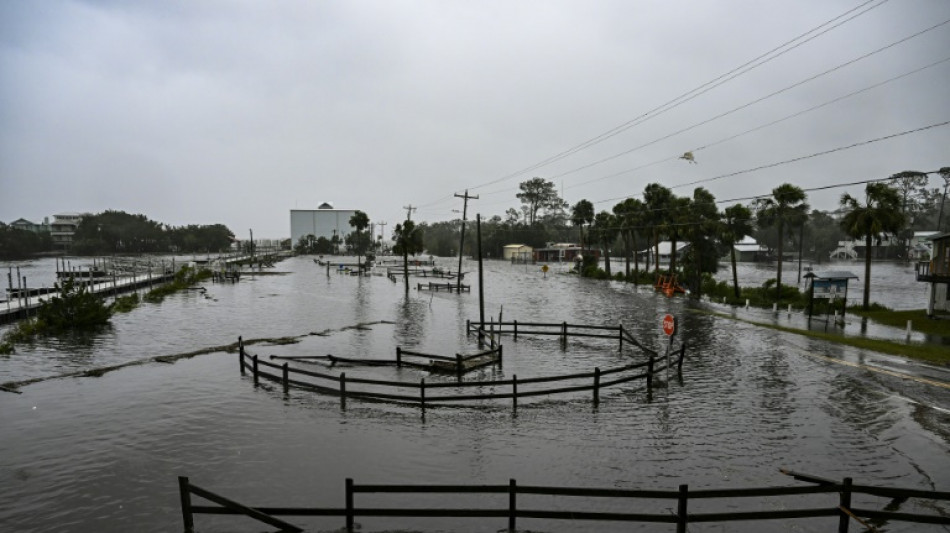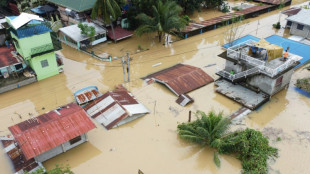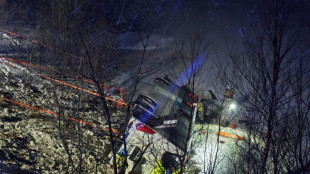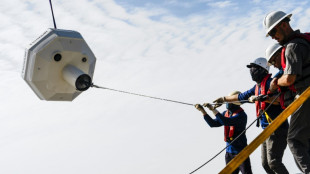
-
 Fresh strike hits Yemen's rebel-held capital
Fresh strike hits Yemen's rebel-held capital
-
Netflix with Beyonce make splash despite NFL ratings fall

-
 Bird flu mutated inside US patient, raising concern
Bird flu mutated inside US patient, raising concern
-
Slovakia says ready to host Russia-Ukraine peace talks

-
 Maresca challenges Chelsea to react to Fulham blow
Maresca challenges Chelsea to react to Fulham blow
-
Tech slump slays Santa rally, weak yen lifts Japan stocks higher

-
 Test records for Zimbabwe and Williams as Afghanistan toil
Test records for Zimbabwe and Williams as Afghanistan toil
-
LawConnect wins punishing Sydney-Hobart yacht race

-
 Barca's Yamal vows to 'come back better' after ankle injury
Barca's Yamal vows to 'come back better' after ankle injury
-
Olmo closer to Barcelona exit after registration request rejected

-
 Watching the sun rise over a new Damascus
Watching the sun rise over a new Damascus
-
Malaysia man flogged in mosque for crime of gender mixing

-
 Montenegro to extradite crypto entrepreneur Do Kwon to US
Montenegro to extradite crypto entrepreneur Do Kwon to US
-
Brazil views labor violations at BYD site as human 'trafficking'

-
 No extra pressure for Slot as Premier League leaders Liverpool pull clear
No extra pressure for Slot as Premier League leaders Liverpool pull clear
-
Tourists return to post-Olympic Paris for holiday magic

-
 'Football harder than Prime Minister' comment was joke, says Postecoglou
'Football harder than Prime Minister' comment was joke, says Postecoglou
-
Driver who killed 35 in China car ramming sentenced to death

-
 Bosch gives South Africa 90-run lead against Pakistan
Bosch gives South Africa 90-run lead against Pakistan
-
French skier Sarrazin 'conscious' after training crash

-
 NATO to boost military presence in Baltic after cables 'sabotage'
NATO to boost military presence in Baltic after cables 'sabotage'
-
Howe hopes Newcastle have 'moved on' in last two seasons

-
 German president dissolves parliament, sets Feb 23 election date
German president dissolves parliament, sets Feb 23 election date
-
Slot says 'too early' for Liverpool title talk

-
 Mayotte faces environment, biodiversity crisis after cyclone
Mayotte faces environment, biodiversity crisis after cyclone
-
Amorm says 'survival' aim for Man Utd after Wolves loss

-
 Desertions spark panic, and pardons, in Ukraine's army
Desertions spark panic, and pardons, in Ukraine's army
-
China sanctions US firms over Taiwan military support

-
 World number six Rybakina makes winning start at United Cup
World number six Rybakina makes winning start at United Cup
-
Israeli strikes hit Yemen airport as WHO chief prepares to leave

-
 Swiatek not expecting WADA appeal over doping scandal
Swiatek not expecting WADA appeal over doping scandal
-
'Dangerous new era': climate change spurs disaster in 2024

-
 Fritz motivated for Slam success after low-key off-season
Fritz motivated for Slam success after low-key off-season
-
Move over Mercedes: Chinese cars grab Mexican market share

-
 Zverev aiming to challenge Sinner for top ranking
Zverev aiming to challenge Sinner for top ranking
-
N. Korean soldier captured in Russia-Ukraine war: Seoul

-
 Inspired Tsitsipas looking to 'refresh, regroup' in Australia
Inspired Tsitsipas looking to 'refresh, regroup' in Australia
-
Seahawks edge Bears to boost NFL playoff hopes

-
 Thunder NBA win streak at nine as Shai ties career high with 45
Thunder NBA win streak at nine as Shai ties career high with 45
-
India announces state funeral for ex-PM Manmohan Singh

-
 Japan govt approves record budget for ageing population, defence
Japan govt approves record budget for ageing population, defence
-
Japanese shares gain on weaker yen after Christmas break

-
 South Korea's acting president faces impeachment vote
South Korea's acting president faces impeachment vote
-
Fleeing Myanmar, Rohingya refugees recall horror of war

-
 Smith century puts Australia in control of 4th Test against India
Smith century puts Australia in control of 4th Test against India
-
Israeli strikes hit Yemen as Netanyahu fires warning

-
 Peru ex-official denies running Congress prostitution ring
Peru ex-official denies running Congress prostitution ring
-
Australia's Smith reaches 34th Test century

-
 NHL Red Wings fire Lalonde and name McLellan as head coach
NHL Red Wings fire Lalonde and name McLellan as head coach
-
The Bilingual Book Company Launches New, Innovative Bilingual Audiobook App

| RBGPF | -1.17% | 59.8 | $ | |
| BCC | -1.87% | 120.675 | $ | |
| CMSC | -0.72% | 23.49 | $ | |
| GSK | -0.22% | 34.045 | $ | |
| AZN | -0.35% | 66.285 | $ | |
| RIO | -0.39% | 59.02 | $ | |
| NGG | 0.66% | 59.313 | $ | |
| SCS | 0.87% | 12.005 | $ | |
| BTI | -0.16% | 36.37 | $ | |
| BP | 0.57% | 29.015 | $ | |
| RELX | -0.5% | 45.63 | $ | |
| JRI | -0.58% | 12.13 | $ | |
| RYCEF | -0.69% | 7.2 | $ | |
| CMSD | -0.8% | 23.29 | $ | |
| BCE | -0.88% | 22.67 | $ | |
| VOD | 0.18% | 8.435 | $ |

Powerful Hurricane Idalia sweeps over Florida, heads north
Hurricane Idalia slammed into northwest Florida as an "extremely dangerous" Category 3 storm early Wednesday, buffeting coastal communities with cascades of water as officials warned of "catastrophic" flooding in parts of the southern US state.
Authorities described Idalia and its potentially deadly high surging waters as a once-in-a-lifetime event for the area most affected, ordering mass evacuations.
The US National Hurricane Center (NHC) said Idalia, which earlier raked western Cuba, was packing maximum sustained winds of approximately 125 miles (215 kilometers) per hour when it made landfall around 7:45 am (1145 GMT) in Florida's marshy Big Bend area.
The NHC said the storm came ashore near the community of Keaton Beach, as an "extremely dangerous Category 3 Hurricane, and warned of a possible disastrous storm surge of up to 16 feet (about five meters) in some coastal areas.
Though Idalia lost strength as it moved inland towards Georgia, becoming a Category 1 storm, authorities warned residents of the aftermath, and the dangers of high tide.
Unlike most other coastal regions in the state, Big Bend -- a marshy area along the Gulf of Mexico -- does not have barrier islands.
The NHC said water levels were more than six feet above normal in Cedar Key, a string of islands jutting into the Gulf, and warned that waters along the coast were "rising rapidly."
Resident Shely Boivin, who manages the community's Beach Front Motel, fled before the storm's arrival, telling CNN that "everything is floating."
"Everything is flooded. I've seen pictures of the tide coming in, the water is just -- it's everywhere," she said, noting that high tide was still yet to come.
In the small coastal town of Steinhatchee about 20 miles south of Idalia's landfall, streets were mostly deserted and the main road was totally flooded.
Patrick Boland, 73, who was out for a walk surveying the damage, said: "It was a little windy, the trees were coming down in my front yard, but other than that, the house is fine."
- Inland to Georgia -
In the Tampa Bay area -- a major metropolitan zone of some three million people -- streets were submerged and flood waters swept across yards.
With the area still at low tide, Tampa Mayor Jane Castor told CNN that "the flooding that we're experiencing now is nothing compared to what we're going to see in a few hours."
Just north in the city of Tarpon Springs, people waded, or even canoed, to safety as homes and apartments were inundated.
More than 278,000 customers in Florida and 52,000 in Georgia were without electricity as of 11:30 am, according to tracking website PowerOutage.us.
US President Joe Biden was due to deliver remarks later in the day on Idalia.
The White House said the Federal Emergency Management Agency (FEMA) had prepositioned emergency personnel and resources.
- Airports, ports closed -
Florida Governor Ron DeSantis had urged residents of 23 counties along Florida's Gulf coast to evacuate and head to shelters or hotels outside the danger zones.
The US presidential candidate had warned the hurricane was on track to be the strongest to impact the region in more than a century.
Meteorologists are also pointing to a rare blue supermoon which could further raise tides above normal levels just as Idalia pounds the coastline.
Tampa International Airport and other regional airports closed, while flights were disrupted along the US East Coast as another hurricane, Franklin, churns in the Atlantic.
Several Florida ports were closed to vessel traffic as of Tuesday night, according to the US Coast Guard.
- 'Marine heat wave' -
In Cuba, the storm flooded several communities including parts of the capital Havana and knocked out power to about 200,000 people but there were no deaths reported.
The storm then moved out over the Gulf of Mexico, which scientists say is experiencing a "marine heat wave" -- energizing Idalia's winds as it raced towards Florida.
Record-breaking temperatures off the Florida coast are expected to amplify Atlantic storms this season, with scientists blaming human-caused climate change for the overall warming trend.
In July, a buoy off the state's southern tip recorded an alarming peak temperature of 101.1 degrees Fahrenheit (38.4C), a possible new world record.
Almost 150 people were killed last year when Hurricane Ian slammed Florida's west coast as a Category 4 storm, bringing ocean surges and strong winds that downed bridges and swept away buildings.
burs-bfm/sst
V.Fontes--PC




